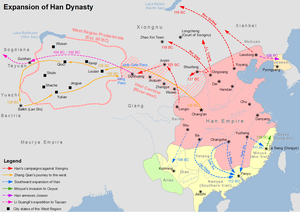
Back قیمومت مناطق غربی (چین) Persian Protectorat des Régions de l'Ouest French Protektorat Kawasan Barat ID 西域都護 Japanese 서역도호부 Korean Vakarų teritorijų protektoratas Lithuanian Rietumu reģionu protektorāts Latvian/Lettish Наместничество Сиюй Russian Protektorat Zapadnih oblasti Serbo-Croatian De västra regionernas protektorat Swedish

| History of Xinjiang |
|---|
 |
The Protectorate of the Western Regions (simplified Chinese: 西域都护府; traditional Chinese: 西域都護府; pinyin: Xīyù Dūhù Fǔ; Wade–Giles: Hsi1-yü4 Tu1-hu4 Fu3) was an imperial administration (a protectorate) situated in the Western Regions administered by Han dynasty China and its successors on and off from 59 or 60 BCE until the end of the Sixteen Kingdoms period in 439 AD.[1] The "Western Regions" refers to areas west of Yumen Pass, especially the Tarim Basin in southern Xinjiang. These areas would later be termed Altishahr (southern Xinjiang, excluding Dzungaria) by Turkic-speaking peoples.[2] The term "western regions" was also used by the Chinese more generally to refer to Central Asia.
The protectorate was the first direct rule by a Chinese government of the area.[2][3] It consisted of various vassal states and Han garrisons placed under the authority of a protector-general of the Western Regions, who was appointed by the Han court.
- ^ Tikhvinskiĭ, Sergeĭ Leonidovich; Perelomov, Leonard Sergeevich (1981). China and her neighbours, from ancient times to the Middle Ages: a collection of essays. Progress Publishers. p. 124. OCLC 8669104.
- ^ a b "Xiyu Duhu" Archived 2007-09-29 at the Wayback Machine
- ^ Yu, Taishan (2003). A Comprehensive History of Western Regions (2nd ed.). Zhengzhou: Zhongzhou Guji Press. pp. 57–59. ISBN 7-5348-1266-6.